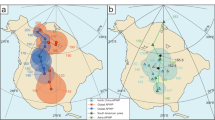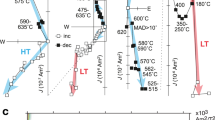Abstract
McKenzie and Parker1 have shown from displacements along faults and from seismic first motions that the North Pacific seems to be moving as a rigid plate relative to the surrounding continents. This motion is uniquely defined by a rotation axis which they estimated to be located near 50° N., 85° W. at the southern end of Hudson Bay. The sense is towards the north-west, clockwise as viewed from the pole. Palaeomagnetic evidence from North America and the magnetization of Pacific Ocean seamounts suggest that this rotation dates from Cretaceous time (108 yr), and that the total angle is perhaps as great as 100°, an average rate of 1° per million years.
This is a preview of subscription content, access via your institution
Access options
Subscribe to this journal
Receive 51 print issues and online access
$199.00 per year
only $3.90 per issue
Buy this article
- Purchase on Springer Link
- Instant access to full article PDF
Prices may be subject to local taxes which are calculated during checkout
Similar content being viewed by others
References
McKenzie, D. P., and Parker, R. L., Nature, 216, 1276 (1967).
Grommé, C. S., Merrill, R. T., and Verhoogen, J., J. Geophys. Res., 72, 5661 (1967).
Richards, M. L., Vacquier, V., and Van Voorhis, G. D., Geophysics, 32, 687 (1967).
Vacquier, V., Proceedings, Benedum Earth Magnetism Symposium, 123 (1962).
Author information
Authors and Affiliations
Rights and permissions
About this article
Cite this article
FARRELL, W. Has the Pacific Basin moved as a Rigid Plate since the Cretaceous?. Nature 217, 1034–1035 (1968). https://doi.org/10.1038/2171034a0
Received:
Issue Date:
DOI: https://doi.org/10.1038/2171034a0
Comments
By submitting a comment you agree to abide by our Terms and Community Guidelines. If you find something abusive or that does not comply with our terms or guidelines please flag it as inappropriate.



